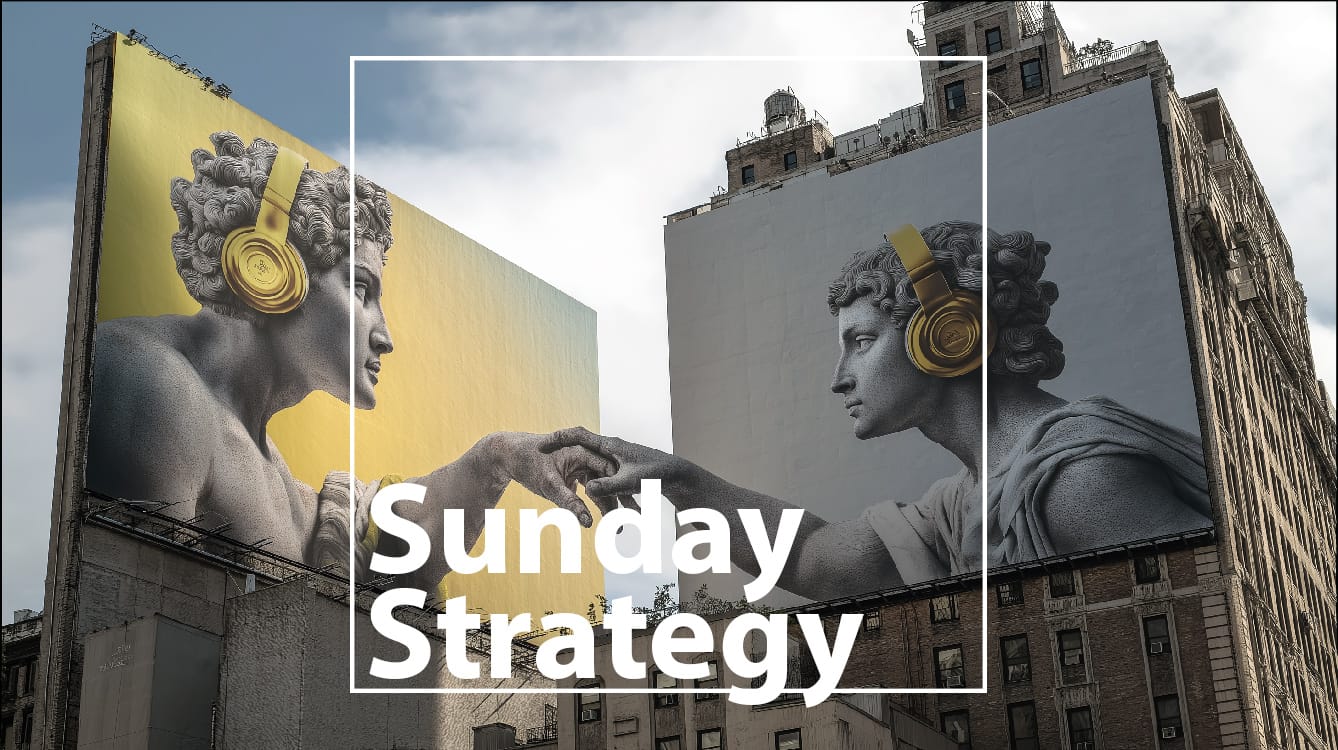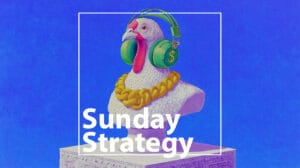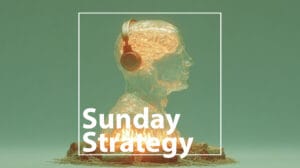In this issue of Sunday Strategy, we look at four stories to think about next week, including: Brands as Agencies for Brands, Gen Z Kills the Midlife Crisis, The Exclusive Turn of Exclusivity and Opting Out of News.
In addition, we have ads from: Nike, John Lewis, NFL and Lego.
// Stories of the Week:
1.) Your Hot New Agency Is Another Brand.
As a marketer, how strong is your brand? Is it so strong you can loan it out to others? Beverage brand Liquid Death’s move to create a new co-branded campaign with mobile network Boost, showcases how brand strength can be transferred. Liquid Death is famous for collaborations, from hot tubs to caskets and diapers, but this is a rare move where a brand becomes another brands’ agency in effect.
Featuring Tony Cavalero (of the ‘Righteous Gemstones’) and borrowing heavily on a ‘Silence of the Lambs’ pun, the campaign takes on the cell phone market with a tone that’s partially Boost and partially Liquid Death. While media partnerships and brand collaborations aren’t rare, advertising collaborations don’t normally see brands taking on roles that agencies traditionally fill. Newcastle’s collaborative Super Bowl ad ‘Band of Brands’ famously crowd sourced an ad with others, but only really used them as a comedic foil. While content house Red Bull & GoPro have long created content together, but on seemingly equal footing.
Liquid Death’s move is notable because it shows the value of brand when speaking to brands. Agencies traditionally fail at branding and marketing themselves, despite a focus to do the same for others. As consolidation and AI leave ‘the cobbler’s kids with even fewer shoes’, it’s not surprising that a brand can find a more attractive partner in another well made brand. Advertising agencies should be careful to ensure that the current existential crisis many find themselves in, doesn’t lead to so much introspection that clients begin to fill the gap working with each other.
2.) Is GenZ Killing the Midlife Crisis?
If so, we probably shouldn’t tell them. The idea that middle age brings a peak of despair is being challenged by new research, showing that younger people are increasingly experiencing the worst mental health, which improves with time. In recent research, the idea of an ‘unhappiness hump’ in our forties across dozens of countries seems to have disappeared. This may have less to do with an increase in happiness amongst forty somethings and more with a relative decline in the wellbeing of younger generations. The flattening of the ‘unhappiness hump’ isn’t necessarily something to celebrate.
As the average 22 year old is now more likely to be unhappier than their parents, we’re left to wonder if generational schadenfreude fills a gap where mid life crisis used to be or if everything is just getting worse…for everyone.
3.) Is Exclusivity Dying or Just Getting ‘Exclusive’ Again?
As members chain Soho House goes private again, co-working space Nueuehouse shutters and other private members clubs struggle to balance scale and exclusivity – are we seeing a step change in how access is sold?
While it would be tempting to say that an age of social media ubiquity has killed the cachet of ‘members only’, the opposite may actually be true. As fashion brand Kith opens ‘Kith Ivy’, a $34k a year private members ‘padel’ club in NYC that will feature the only Erewhon in the city – in the form of a tonic bar, it’s safe to say that exclusivity and gate keeping are alive and well. Instead, we may be seeing a shift in the brands that can authentically capitalize on it’.
4.) What Happens When More People Tune Out the News?
News avoidance is at an all time high globally, as recent research shows 40% of respondents across 50 countries say they sometimes or often avoid the news (up from 29% in 2017). The tone, severity, amount and political polarization of news are all said to be to blame. However, is there a line between disconnection and stopping ‘doom scrolling’? An informed public is, still potentially, an empowered one, so finding ways to inform without overwhelming is needed for the health of communities, politics and countries overall.
// Ads You Might Have Missed:
1.) ‘Why Do It’ – Nike:
How do you re-introduce something most people already know like Nike’s ‘Just Do It’? Nike’s latest campaign takes on the impossible task of putting new meaning around one of advertising’s most known phrases. ‘Just Do It’ is all about action and movement in the face of adversity and doubt, but its latest iteration sees more meaning built alongside it. ‘Why Do It’ introduces a new dimension to the line by highlighting the forces and doubt it’s always seemingly ignored.
The brand believes that a younger, anxious generation needs more acknowledgement of what they’re facing instead of just a rallying cry to move beyond it – something a pile of recent research backs up. Even a look at modern athleticism shows where the opportunity to shift is coming from.
Quoting sponsored athlete Carlos Alcaraz, the new dimension to the brand comes through pretty clearly – “Tennis teaches you quickly that you can’t control everything, but you can always choose to fight for that next point, sport is about that courage to keep going, to stay fearless and to believe in yourself no matter the pressure or the moment.” Whereas the second half of that quote is traditional Nike, the first half is a more balanced view of sport’s challenges. The added elements of acknowledging failure create nuance, and pull it away from a grittier brands like Under Armour, but do they come at the cost of its single mindedness?
The greater risk seems to be carrying on for the sake of heritage alone. In a world where attitudes to sports, winning and performance are becoming more rounded, it looks like Nike has as well.
2.) ‘Tableau’ – John Lewis:
The single take ad seems to be the flex du jour of talented creatives in an age of AI, and what started with Britbox continues with John Lewis, in an ad celebrating 100 years of the British retailer’s heritage in one take. The ad, soundtracked by The Streets’ Mike Sinner covering ‘The Beat Goes On’ (we’re definitely a ways from ‘sharking for a minute to get chips and drinks’), encapsulates so much Britishness (that the brand can truly claim) it feels bigger than John Lewis until the end. For a retailer normally known for tear jerking holiday storytelling, this ad pushes a different approach to show the passage of time before we get into more expected holiday territory in a few months.
3.) “Ride the Float” – NFL:
To celebrate the start of the new NFL season, the league has combined fans, its teams, the Quad City DJ’s and the Rizzler into an amalgamation of an ad that feels more suited to be in pieces across an Instagram feed than on TV. Featuring a literal parade of AI generated mascots and fan art, borrowed heavily from every carousel of ‘What your team would look like as an ‘x’’, the NFL takes AI internet culture and puts it on show. While AI (and advertising) purists and cynics alike will find something to hate in this, we have to begrudgingly admit that the league has bathed itself in what its fans are sharing and liking with this effort. Don’t hate it because it’s AI, hate it because it has your rival team in it.
4.) ‘Never Stop Playing’ – Lego:
Lego’s latest ad features Tom Holland in something that’s part Marvel blockbuster, part Nike football ad, part AC/DC music video and part Lego rallying cry. ‘Never Stop Playing’ features the actor in various scenes espousing the need to keep playing, with a tone that showcases the brand’s position as an entertainment property as much as a toy brand. Its different vignettes borrow from various similar setups (from Avenger’s films to Art and Nike Football) without copying them explicitly – showcasing the brand’s core belief in different ways while sneaking in a variety of products and builds.
// Sunday Snippets
// Marketing & Advertising //
–Valentine’s Day candy ‘Sweethearts’ has dropped a ‘ghosted’ version for Halloween. Truly scary. [Romance]
– Applebee’s launches a phone case to hold a pretzel – creating an idea that’s as unhygienic as it is greasy or crumbly [Ads]
– ALDI has launched an own-brand version of Guinness in the UK, but can it succeed while people split the Faux-G? [Food]
– 51% of US credit union members still prefer banking in branch vs. online – which may be less about the power of physical and more about how much people like their credit union [Finance]
– Singapore Airlines gives a tour of what makes Singapore special while talking about safety in their latest ‘in flight’ video [Travel]
– Betting site Fan Duel has stepped in to fund extra express trains for fans going to the Eagle’s NFL season opener [Sports]
– Have British coffee chains ‘lost’ the Matcha generation [Food]
– Inside Red Lobster’s plan to rebuild the brand with Black diners [Food]
// Technology & Media //
– YouTube’s latest trend report unpacks 14 to 24’s internet usage and ‘Creative Maximalism’ [Social Media]
– OpenAI are reportedly building a competitor to LinkedIn [Social Media]
– What happens when patients turn to ‘Dr. Deepseek’? [AI]
– Google breaks down the ‘ROI of AI’ by speaking with 3500 executives about it [AI]
– OpenAI takes a similar approach to help executives implementing AI consider where they are in their enterprise deployments [AI]
– A Google engineer also breaks down the thorough considerations of building agentic systems in a new guide [AI]
– One of the world’s largest piracy streaming sites, Streameast, has reportedly been shut down [Media]
– What does the Oura Ring x Palantir partnership mean for your data and privacy? [Technology]
// Life & Culture //
– The vibe of the American middle class has shifted from secure to squeezed [Finance]
– FC Augsbergs’ new ‘Roman Gladiator’ inspired tunnel for players is a new one [Sports]
– Beta Blocker use is on the rise for situational anxiety, especially amongst young women [Health]
– After teasing a return to frontline politics, only 7% of Brits say former UK PM Liz Truss should. No word on the lettuce that outlasted her or its plans. [Politics]
– GAP drops a travel hoodie complete with inflatable pillow built in [Fashion]
– In the modern office, we show up on time but leave early. [Work]
– The New York Times asks ‘is partying dead or are you just old?’ And I creakily respond ‘probably the latter for some time’ [Culture]
// Until Next Sunday
As always, let me know what you think by email (dubose@newclassic.agency), website or on LinkedIn.
You can also listen to an audio summary and discussion of each week’s newsletter on Spotify. We’re also on TikTok!





